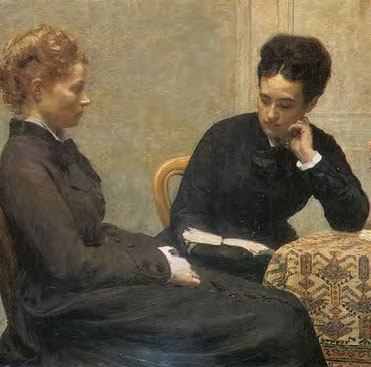Posted on August 24, 2016 in Arts & culture.
Fantin-Latour exhibition at the Luxembourg museum
This exhibition is produced by the Réunion des musées nationaux - Grand Palais and the Musée de Grenoble, in collaboration with the Musée d'Orsay. It will be presented from March 18 to June 18, 2017 at the Musée de Grenoble.

Henri Fantin-Latour, La Lecture (detail), 1877, oil on canvas, 97 x 130 cm, Lyon, Musée des beaux-arts, Photo © Alain Basset
First retrospective of the work of Henri Fantin-Latour (1836-1904) in Paris since the exhibition of
reference devoted to the painter in the national galleries of the Grand Palais in 1982, this exhibition highlights the most emblematic works of an artist best known for his still lifes and his group portraits, and also reveals the important part occupied in his work by the so-called "imagination" paintings.
Very attached from his youth to the faithful restitution of reality, Fantin-Latour also explored, with delight, a more poetic vein which brings him closer to the Symbolists. The exhibition, which embraces all facets of this rich career, offers a dense journey bringing together more than one hundred and twenty works, paintings, lithographs, drawings and other preparatory studies.
Following a chronological plan, the exhibition opens with the artist's early works, in particular the disturbing self-portraits he produced in the years 1850-1860. Confined in the workshop, Fantin-Latour then finds his sources of inspiration at the heart of his intimacy: captive models, his two sisters are staged in reading lamps or in embroiderers, while the still lifes skilfully composed of the 1860s reveal, already, the exceptional observation qualities of the young artist. The highlights of the decade 1864-1872, a pivotal period in Fantin-Latour's work, are highlighted in the second part of the exhibition. Driven by great ambitions, the young artist then worked intensely, innovating with panache in the field of group portrait. With the Homage to Delacroix, the first of his great group portraits, he inscribed his name in the history of a certain modernity, alongside Delacroix or Manet. With Le Toast (1864-1865), Un atelier aux Batignolles (1870) and Coin de table (1872), he multiplied works worth manifestos.
The third part of the exhibition presents the series of still lifes and portraits that the artist produced between 1873 and 1890. With the exception of commissioned portraits, which are gradually becoming scarce in his work, he qualifies himself most of these canvases of "studies from nature". The sumptuous portraits of flowers which he then painted in dozens testify to a rare talent in the composition of bouquets as well as an exceptional virtuosity in the rendering of materials. His portraits, whether posed or more intimate, also illustrate a keen sense of observation.
However, the artist gradually grew tired of portraits and still lifes, as revealed in the fourth part of the exhibition. "I am pleased": with this sentence written in a letter to his friend and merchant Edwards in 1869, Fantin-Latour evokes the so-called "imaginative" works which occupy an increasing part in his work over the years. Nourished by his passion for music, inspired by mythological subjects or odes to the beauty of the female body under the cover of chaste allegories, these works reveal a less known face of the artist.
Between the austerity of the family portraits, the richness of the still lifes and the enchantment of the imaginative pictures, there emerges a character full of nuances, whose complex personality is illuminated by the abundant correspondence which he maintains with several of his friends and artists of the time. The exhibition also innovates by devoting a room to the creative process of Fantin-Latour which, centered on The Birthday painted in 1876, presents in parallel paintings, drawings and lithographs reworked many times. This retrospective is finally an opportunity to reveal to the public an unprecedented corpus of photographs, capturing a repertoire of forms for the artist.
Beyond highlighting the traditionally minor genre of still life, erected by Fantin-Latour as a true portrait of flowers, the exhibition aims to paint the image of an artist engaged with the debates of his time, between passion for reality and the need for escape, which has established itself, despite its discretion, as an outstanding figure of its century.
police station: Laure Dalon, curator at the Rmn - Grand Palais, assistant to the scientific director; Xavier Rey, curator at the Musée d'Orsay, and Guy Tosatto, director of the Musée de Grenoble.
Pratical information
19 p.m., Friday night until 22 p.m.
prices : € 12, TR € 8,5 (16-25 years old, job seekers and large families), Special Youth: € 8,5 for two tickets (Monday to Friday from 17 p.m.), free for children under 16 years, beneficiaries of social minima
access: M ° St Sulpice or Mabillon Rer B Luxembourg - Bus: 58; 84; 89; Luxembourg Museum / Senate stop
Information and reservations: museeduluxembourg.fr
Drawing Now Art Fair: Tatiana Wolska winner 2024
The invention of language by Gertrude Stein and Pablo Picasso
The history of French women's golf at Golf du Sorbier








